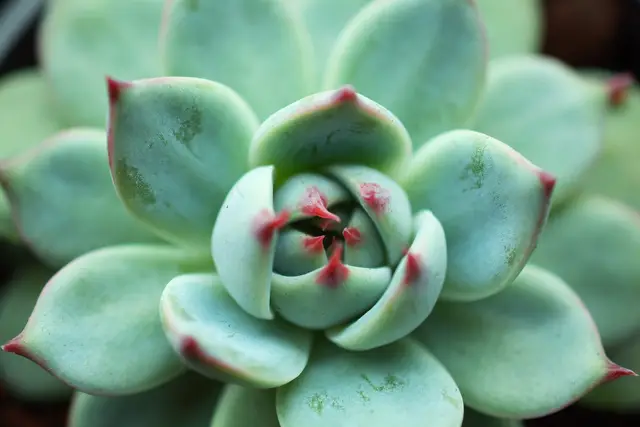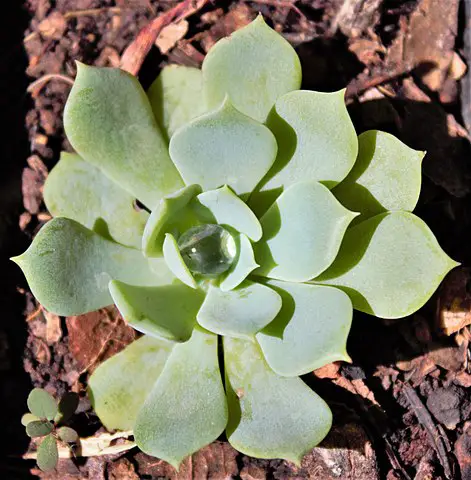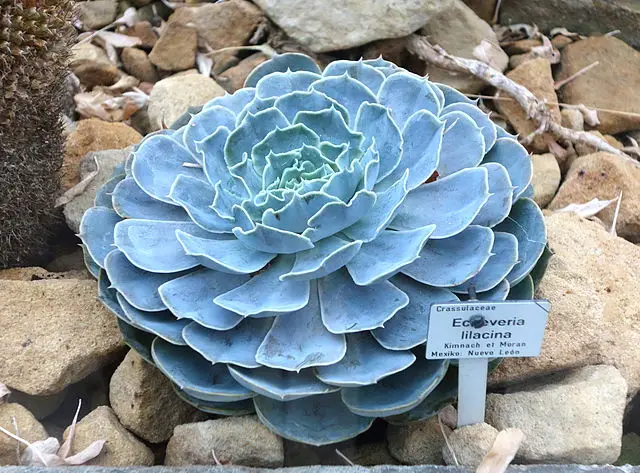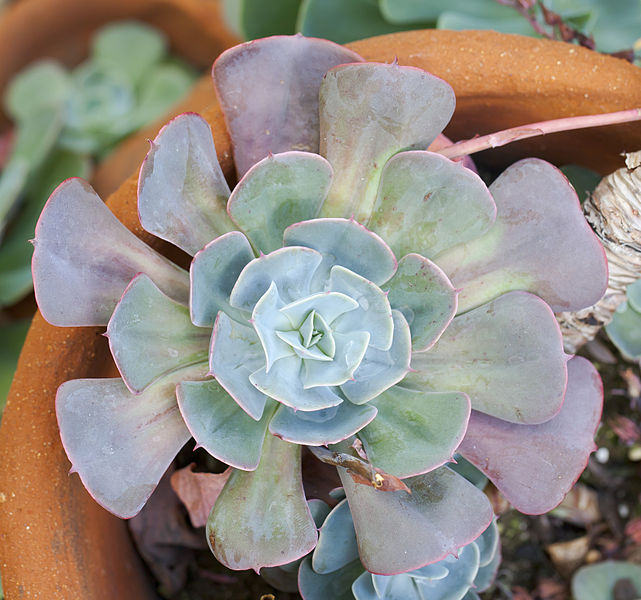Echeveria chihuahuaensis is an attractive, multi layered, round succulent which is a native of Mexico and grows in many different shades. Generally however, the leaves tend towards a pale, grey-green in colour, often with vivid red tips. It grows broadly, spreading outwards as opposed to upwards, and flowers in spring, when it sends up one or two single shoots of delicate, bell-shaped flowers which can range from bright yellow to warm coral-pink.
They can look very dramatic in a well-arranged indoor display and although they are perfectly happy as houseplants, in a temperate climate, they can benefit from spending at least 4-5 months outside in the sun although this depends on your area’s tendency to frost.
Echeveria Chihuahuaensis belongs to the Crassulacea family of which there are currently around 150 species. However, there are also hundreds of hybrids.
Sometimes the leaves can be quite placid, plump and soft in appearance, with a dark pink outline, others can be flatter, rather more stiff in appearance, more pointed and almost ecclesiastical to their dark red tips but all species present a wonderful circular display of leaves, layer upon undulating layer, ascending to a crown in the center, in gentle shades of green.
Habitat
Coming from Mexico and other areas of central America, the Echeveria Chihuahuaensis’ natural habitat is warm, with plenty of sunshine and a tendency towards a drier atmosphere. It thrives in rocky, mountainous areas with a good circulation of air. Humidity does not suit them, so care should be taken during propagation.
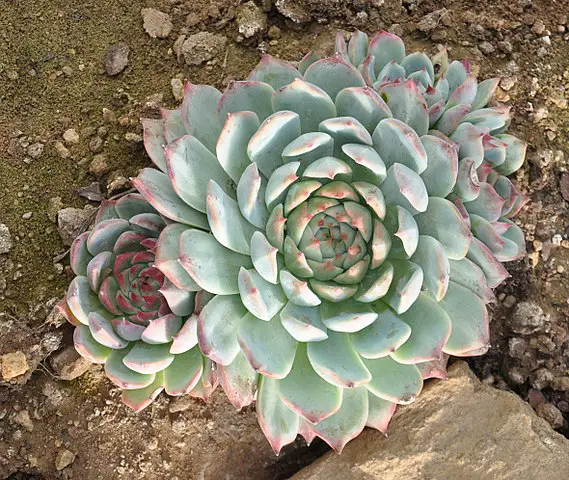
The name chihuahuaensis comes from the state of Chihuahua which is mostly desert, so unlike some echeveria species which live further to the south, the mountainous areas which echeveria chihuahuaensis inhabits are much rockier and less lush, meaning this is one of the most aridity-adapted succulents. This means it is one of the less tolerant succulents in terms of overwatering so be sure to take care in when and how you water and not to neglect it.
Echeveria Chihuahuaensis Growing Requirements
It all starts with the soil. Echeveria chichuahuaensis prefers a pot with plenty of drainage and room to expand. The most important thing is to not let the roots become sodden or sit in water at all, otherwise echeveria chihuahuaensis, like many other echeveria species, will develop root rot.
Echeveria Chihuahuaensis Soil
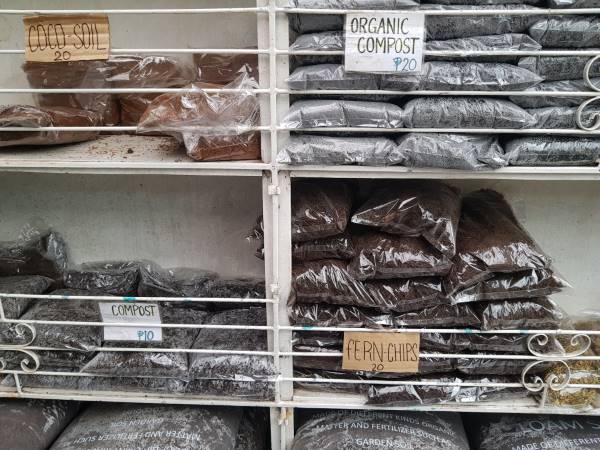
There are many different pieces of advice on the best soil to use for echeveria chihuahuaensis but the best soil is one which works in line with its natural habitat. You may hear about specialist cactus and succulent soils which are designed for a wide range of succulent plants, or about perlite, which is an absorbent volcanic glass which expands during the heat and retains water. This helps keep the roots of your succulent dry. It advised to mix the perlite with sand or to mix sand or sand and perlite with your regular soil.
All these are options designed to best set up an environment as similar to echeveria chihuahuaensis’s natural habitat as possible. However, it is important to note that it is not just soil which is important and that for a fully thriving echeveria chihuahuaensis all the conditions of its natural habitat are necessary for it to respond in the optimum way to watering and heat.
Therefore, fertilisers and other quick solutions designed for cacti and succulents are not necessarily the best choice so long as you are in tune with your individual plant and have a good working knowledge of how it interacts with the conditions in its natural habitat in the wild, including weather patterns and response to the rest of the surrounding ecosystem.
To create the ideal soil, don’t be afraid to work with what your plant responds to best even if it is not specifically recommended, as homemade soil mixes can be extremely versatile and work well depending on how your plant grows in the specific conditions of your particular climate.
Echeveria Chihuahuaensis Light Requirements
When echeveria chihuahuaensis is in good condition it is an extremely striking looking plant which is ready to grow and thrive but in the wrong conditions it’s appearance can change drastically. If given very intense sunlight, whether this is from outside or through a window hitting your indoor plant, the leaves can actually become sunburnt, so be very careful of the positions of your plant and what it receives in terms of resources.
If the climate you live in is close enough to it’s semi-arid habitat – which can be classified as US zones 9 to 11 but can be expanded to all semi-arid areas providing there are the right levels of heat and dryness – it can be kept outside, but it should not be exposed to frost at all.
However, echeveria chihuahuaensis does appreciate a difference in temperature between winter and summer, with it being adapted to slightly cooler temperatures of around 10 – 20 degrees celcius in the winter and 20 – 30 degrees celcius in the summer. In fact, it is dormant in winter but come summer enters its growing season during which it produces it’s long and elegant flower stalks.
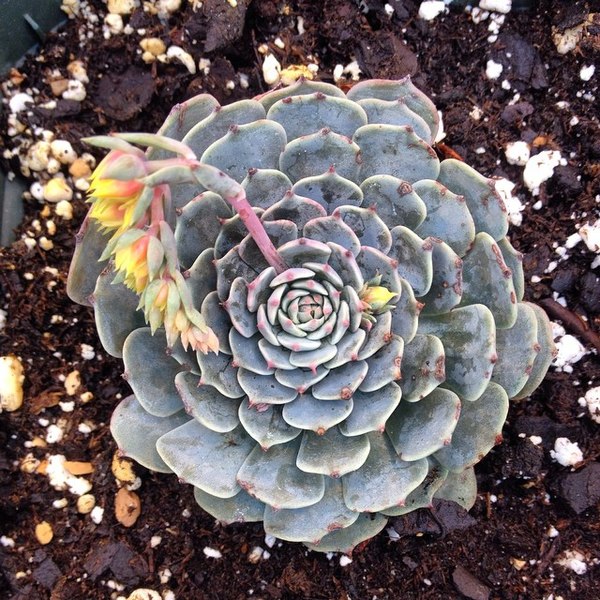
Flowers are coral pink with yellow insides and the stems are pink as well, providing a striking contrast with the rest of the plant’s foliage which remains the same blue green colour. Once echeveria chihuahuaensis is mature it develops the ability to produce offsets, generally two to three per growing season, and these take the form of smaller rosettes around the base of the stem.
Repoting of Echeveria Chihuahuaensis
Growing season is also the best time for repotting your echeveria chihuahuaensis as the plant has enough energy to cope with the stress of moving pots. This procedure is not advised to be done regularly as echeveria chihuahuaensis spends a long time growing and strengthening its roots by stretching them out to find pockets of water in the soil during the dry season, so when repotting, be careful not to damage its roots as these are what gives it it’s remarkable ability to withstand the conditions it does in its natural habitat.
Echeveria Chihuahuaensis Pests and diseases
Due to the arid climate in which it lives, echeveria chihuahuaensis is one of the least tolerant plants of damp and moisture, and this is one of the factors which must be taken into account when keeping this plant at home. For starters, a rule which applies to all echeveria species also applies here – never keep your echeveria chihuahuaensis in a bathroom. However, other practices which are aimed at reducing moisture around your echeveria chihuahuaensis are also especially advised because of its love for aridity.
This firstly includes removing dead and shrivelled leaves from around the base of the plant, not only allowing fresh air to circulate, but also preventing the correct environment and breeding grounds for pests such as mealybugs, vine weevils, aphids, and scale insects.
Watering carefully is also especially advised for the same reasons – to reduce moisture in and around the stem and leaves but also to prevent moisture staying on the leaves, which causes them to rot. Water the soil as opposed to the leaves and you can avoid problems to do with leaf rot.
A deep watering pattern as outlined in the section on watering is also important to keep your echeveria chihuahuaensis dry. However, if you have overwatered your plant, a change of soil may be necessary in order to prevent it developing root rot. Either the soil can be changed entirely or it can be partially changed and a mixture of fresh sand and perlite added in addition to what is already there. This can absorb some of the excess moisture around the roots and help them dry out more quickly than if you simply waited for all the water to absorb.
Echeveria Chihuahuaensis Propagation
Once you have an echeveria chihuahuaensis it is fairly easy to propagate as in fact this plant, like many of the species in the echeveria family, is actually self-propagating via it’s offset formation process. If you do wish to propagate it, this can be done by stem, by leaf, by offsets, or the plant can even be grown by seed. Nevertheless, it is important to acknowledge that the propagation process can cause stress to the plant if not done in the correct way – and therefore this must be taken into account when propagating.
Leaf Propagation – Step by Step
Propagating an echeveria chihuahuaensis by leaf involves the removal of a leaf or leaves from the main stem and because of the inherent stress this can cause the plant it is extremely important to do this gently and carefully because otherwise it may damage the main plant. Leaves should be wiggled from side to side in order to break them off fully from the stem and not to damage either the main plant or the leaf itself, as broken leaves do not take root.
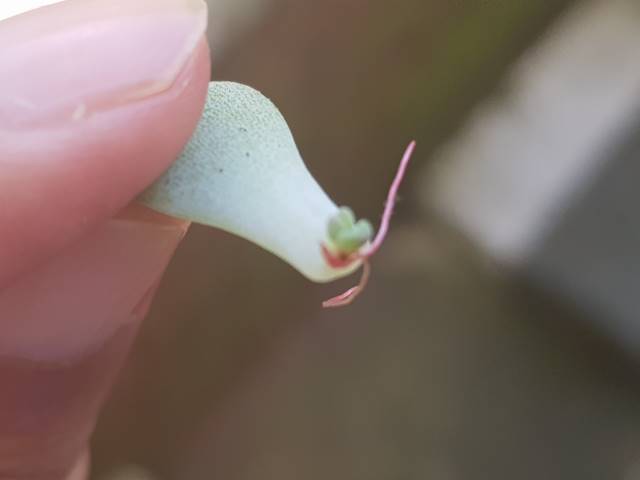
Once your leaf or leaves have successfully been broken off leave them on soil or on a clean piece of kitchen towel and wait for the end of the leaf to callous over which means that the break from the main plant has healed and the leaf is ready to grow new roots. Ensure that you keep the leaf dry until the main leaf has shrivelled up – by this point the new plant should have grown and can then be planted in soil.
Offset Propagation
Offset propagation, in contrast to leaf propagation, involves using the plant’s natural processes of growth and does not involve cutting anything off the plant – only severing the stem that connects the offset to the main plant instead. Echeveria chihuahuaensis produces offsets during the summer, which is it’s growing season.
In the wild, these attach to the soil of their own accord, putting down roots some distance away from the larger plant. Once they have fully attached to the soil the stem which connects them to the main plant withers and the new plant begins to grow of its own accord – no longer receiving nutrients from the main plant and instead finding its own in the soil as it grows its roots and starts looking for water. Nevertheless, these offsets often grow near the main plant and together they share the same ecosystem where at first the larger plant may shield the smaller one from the elements.
Both propagating by offset and propagating by seed are processes which are similar to the natural reactions of the plant in the wild. In the case of leaf propagation, this recreates the processes which follow after a plant drops leaves in the wild, as this is an adaptation designed to maximise growing potential even when the plant is damaged.
Growing from Seed
Propagating from seed is the most difficult as some of the parent plants can actually produce sterile seeds. It takes time and patience, but can be done outdoors in a warm dry climate or indoors in a more temperate area. Each seed should be bedded in soil that is almost dry to touch, but not entirely and in an individual small container or seed tray. Protect them under a clear cover with a good dose of sunlight or natural light but at this stage, not in direct, fierce sunlight which will overwhelm them. The new plants should appear after two-three weeks.
In conclusion, echeveria chihuahuaensis is a delightful desert dwelling succulent which displays it’s colours vividly when kept in the right conditions and can be a welcome plant for any succulent lover to keep. It is a great plant for beginner succulent growers who wish to become more acquainted with the echeveria genus and learn how to propagate this plant and encourage growth of its striking and distinctive looking flower stalks. With the correct conditions, echeveria chihuahuaensis is a plant which is sure to become an enjoyable part of any succulent lover’s home.
Featured Photo Credit: Jean-Michel Moulle

